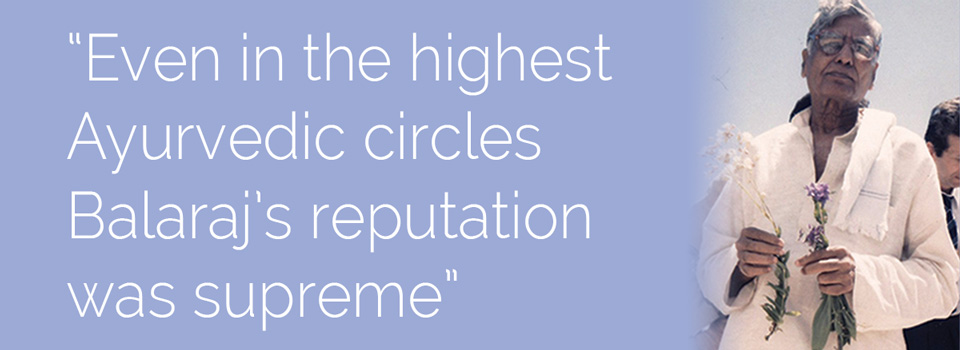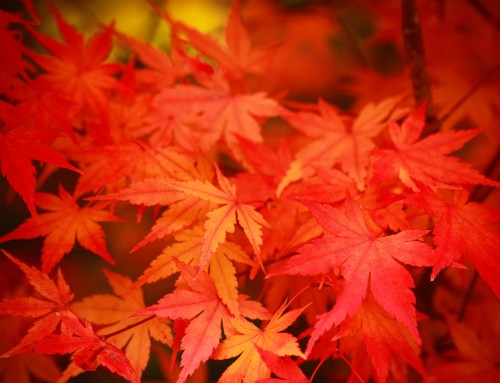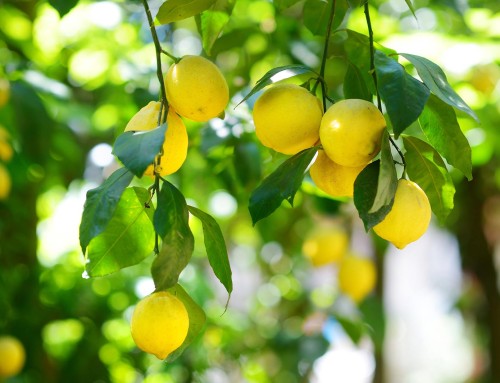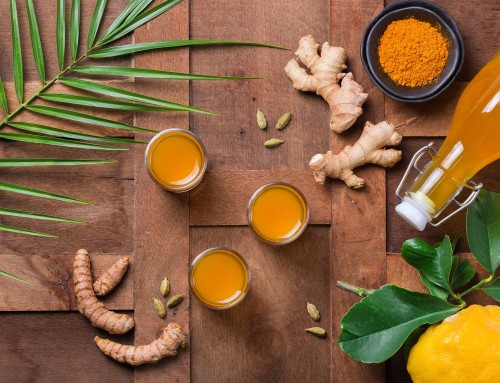My first meeting with Balaraj
In June 1984, I became part of a group of western-trained medical doctors from six countries who began a 15-month course in Ayurveda. In February 1985, as part of our course, we were invited to join a group of eminent vaidyas (Ayurvedic doctors) in Brasilia, for a two-week conference on the indigenous health traditions of South America. It was here that I first came into contact with Balaraj Maharishi, generally acknowledged to be one of the great Vaidyas of his era. At that time he was the adviser on Ayurveda to the Government of Andhra Pradesh.
During the conference he soon came to the notice of our group. Maharishi Mahesh Yogi acted as chairman and each session had a number of speakers and would usually last many hours. As we sat watching the proceedings, we could not help noticing that one person on the stage sat for hours hardly moving at all. The stillness surrounding him was palpable. Even after the first session, our group all wanted to know who he was.
We were told that this was Balaraj Maharishi, a senior and highly respected Vaidya, regarded as the greatest living authority on Ayurvedic medicinal plants and their uses – the science of Dravyaguna. We arranged a meeting with Balaraj where told us something of his life story.
Meeting his Master
As a 17 year old he had been travelling by train in North India when he witnessed a train guard demanding payment for his fare from a sannyasi (wandering holy men). I seemed that it was the tradition in India to allow sannyasis free passage on trains. He remonstrated with the guard, but ended by paying the sannyasi’s fare.
After boarding the train the sannyasi seemed very much amused by the incident and asked the young man what he intended to do with his life. Balaraj said he wished to make people happy and so was considering music. He had run away from home and was on his way to Madras to learn a traditional instrument from a group who had recently visited his village.
On hearing this, the sannyasi offered to give him something more precious, and invited Balaraj to follow him. He turned out to be a highly experienced vaidya, with a lifetime’s knowledge of medicinal plants and their uses. Thus Balaraj became a student of a vaidya sannyasi (celebrate Ayurvedic practitioner).
Ayurvedic training from a Sannyasi Guru
From then on, wherever they walked through forests, fields or deserts of India, every time they met a plant his master would tell him all about it – it’s name, family, genus, properties, uses, in what combinations it could be used, and for what conditions etc. For many years they had walked the length and breadth of India, particularly in the Himalayas, as his instruction continued. It was reputed that Balaraj gradually acquired a detailed working knowledge of over four thousand medicinal plants.
One day in Brasilia, it was decided that the visiting Vaidyas would join that a group of traditional practitioners from South America on a field trip into the jungle to study local plants. By the end of the day, Balaraj Maharishi had earned the respect of all. Whenever they had come to a plant whose identity or health benefits were unknown to all others, Balaraj would explain everything about it, Sanskrit name, Latin name, common name and uses of its different parts. His knowledge seemed encyclopaedic. He was subsequently described as ‘sarvagyan oushadhi’ – having universal knowledge of plants.
Thirty years after first meeting his master, the sannyasi told him to go and give this knowledge to the world. Thus, after many years training with his sannyasi guru, his own professional career started.
Healing camps in rural India
Balaraj began by setting up camps over the whole of rural India and, in this way, his reputation began to grow.
His modus operandi was to hold a camp for a week, during which time many thousands of sick people would come. He, and his growing number of vaidya apprentices, would work day and night seeing patients for the entire week. He would treat the more difficult patients himself. After the week’s camp, the following three weeks would be spent collecting plants and processing them for the next camp.
Balaraj’s closest student in his healing work was Dr Raju from Hyderabad, whom we also met in Brasilia. Dr Raju explained how the tribal peoples of the forests revered Balaraj – they would collect plants each month for him, and he, in return, would then visit them to treat and heal their sick.
Ayurveda for snakes and lions
Dr Raju told us many stories of their forest sojourns. For example, one rare plant called bhutumbi (1) is of great medicinal value. But cobras like to build their nests around its roots – to such an extent that cobras are usually found wherever it grows. Those trying to harvest bhutumbi are in danger of snakebite from the disturbed snakes who, naturally, do not wish to see their home destroyed. So how to pick it?
The answer was stunningly simple, literally! Balaraj would throw a powder into the nest, which would stun all the snakes for half an hour. Then they would dig out the plant and Balaraj would throw another powder on the snakes. Dr Raju asked him, “Why the second powder?” Balaraj explained that that was in case any snake was cut in the process of digging – the second powder would help heal its wounds! He also practised Ayurveda for snakes.
According to Dr Raju, another of Balaraj’s powders was reserved for lions – but for a different purpose. If they happened to cross the path of a ‘King of the Jungle’, Balaraj would throw his ‘Lion Powder’, and the lion would ignore the group.
A very ancient Guru
Balaraj ended his life’s story by saying that no year went by without his returning to visit his guru in the Himalayas. When asked if he meant the old Sannyasi he had met him at age 17, he consistently said, “Yes, of course”. In 1985, Balaraj was said to be in his seventies, so it must have been about sixty years later. Dr Raju also confirmed that Balaraj used to visit his guru annually up to a few years before he passed on in 2001. The age of his revered guru must have been beyond all normal life-expectations.
Turning a deadly poison into a healing medicine
On other occasions, Balaraj Maharishi revealed further aspects of his skills and his life. On one occasion in India, he was shown a sprig of oleander, which had been growing in the courtyard of the place where he was staying. Although it is a beautiful ornamental, oleander is also exceedingly toxic. In addition to containing the well-known toxins oleandrin, atropine and strychnine, oleander contains dozens of other cardioglycosides, all of which can be fatal. Western medicine recognizes no beneficial dosage level for its extracts.
When asked whether he knew any use for it, Balaraj held the sprig in his hand and considered it carefully. “Yes,” he replied, “if you soak the leaves in lemon juice overnight, and then boil the solution until it forms a jelly on cooling, a pin head of that jelly will be a cure for malaria.”
Request from Lord Mountbatten
Even in the highest Ayurvedic circles, Balaraj’s reputation was supreme. He once related how, after independence in 1947, when the British were finally leaving India, Lord Mountbatten, the last Viceroy, had requested him to accompany their group back to England, saying that they needed people of his quality. He had declined, on the grounds that his duty lay with his own people in his homeland.
On another occasion, he instructed one of my colleagues that people in the west ‘should now receive the full wisdom of Ayurveda’. This project was one to which he later gave considerable support, conducting the first trial of Ayurvedic medicines in the west (2).
To help spread the knowledge of Ayurveda internationally, Balaraj began traveled widely thoughout Europe and the Americas, instructing medical doctors in the use of Ayurvedic herbs.
The birth of Amrit Kalash
One day, in response to a question, “Do you know a single formula, which is good for every disease?” Balaraj replied that, in ancient times, just such a question had once been posed by a great King to his entire team of rajvaidyas (royal physician). Their answer, which had never been written down, had been known to a sadhu-vaidya, who had passed it to Balaraj many years earlier, with instructions that it should be used to benefit all humanity.
Balaraj Maharishi decided to name the product ‘Amrit Kalash’, since he first presented it in a silver kalash container, describing it as pure amrit (nectar). Thus came about the Maharishi Amrit Kalash Ambrosia Tablets.
The first research trial on Maharishi Ayurveda
From the perspective of modern science and integrative medicine, Balaraj’s greatest contribution may well have been his supervision of one of the first published formal scientific trials (possibly the first) of Ayurvedic remedies conducted in a foreign country (2).
To validate the efficacy of Balaraj’s herbal formulae, in Holland a trial of chronic diseases was set up by a Dutch scientist, the late George Janssen. The trial was conducted under the supervision of a Dutch health insurance company, Zilveren Kruis (Silver Cross). It measured the effects of Ayurvedic medicines on chronically ill patients, with no hope of recovery.
Since the patients were regarded as incurable in western medicine, and were longterm users of palliative drugs, any improvements in their underlying condition could only be understood as being due to the Ayurvedic treatment. For this reason, no controls were deemed necessary.
Despite such negative circumstances, the results of Balaraj Maharishi’s individualised Ayurvedic treatments were very successful (2). Zilveren Kruis stated that they would be willing to pay for any of their insurees suffering from pathologies and treated according to Balaraj’s Ayurvedic prescriptions.
During the trial the patients had been given full Ayurvedic treatments, including ahara / vihara (diet / lifestyle) recommendations as well as aushadi (herbal medicines).
Ayurveda complimenting western medicine
This trial therefore does not in any way constitute a test of herbal formulae vs. chemical drugs. It is a comparison of the full treatments of two potentially complementary medical systems, in cases where one – modern medicine – was not able to improve the underlying condition.
The conclusion that followed was that the integrative practice of the two systems of medicine working together would greatly benefit overall treatment outcomes, and the future quality of a patient life. Balaraj’s research thus points to the advantages of adopting integrative practice, so that more than one system is available to fit individual patient’s needs.
Balaraj’s wonderful rapport with patients
Balaraj often had a wonderful rapport with his patients. One of those who helped with the Zilveren Kruis study was Wim van den Berg. Wim recalls his father, who did not speak any other language than Dutch. His was about 80 years old at that time – possibly a little older than Balraj Maharishi himself. He came to have a consultation as part of the study. Balraj, Wim said, sat in his office like a King, receiving patient after patient with the aura of an elderly and wise saint, and helped by a translator who translated from English to his native Telegu.
Wim recalls an amazing intuitive contact and understanding between Balraj and Wim’s father, almost without any verbal interaction. Although a few things were translated here and there, apart from the odd gesture, it was as if the two of them spoke from heart to heart at silent level. It was as if his father had just come to meet an old friend and Balraj seemed to immediately understand the other man’s problems.
His father had never previously expressed interest in Ayurveda, and Wim had been surprised at his willingness to participate in the study. Then, on meeting Balraj, his father had melted and become enthusiastic to take Ayurvedic medicine. He had even started feeling good about his son’s choice of profession.
References
- Bhutumbi, also known as ‘Nagatumbi’ (Naga = snake + tumbi = tuber).
- Janssen, G.W.H.M. (1989). De Maharishi Ayur-Veda behandeling van tien chronische ziekten: Een voorstudie (The Maharishi Ayur-Veda treatment of ten chronic diseases: A pilot study). Nederlands Tijdschrift voor Integrale Geneeskunde 5, (35), 586-594.






